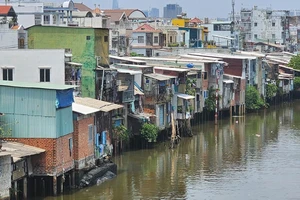 |
A corner of Hiep Phuoc - Nha Be Port in HCMC. (Photo: SGGP) |
Many experts are concerned about how to make this port connect with existing ones to create general strength.
About a year ago, the construction of a large seaport in Can Gio District was the proposal of MSC Group, the world's largest seaport group, and Vietnam Maritime Corporation (VIMC) to the government on the occasion of Prime Minister Pham Minh Chinh's visit to Europe. This project has been advocated by HCMC, the Ministry of Transport, and many other related agencies. Especially, most recently, in Resolution No.31-NQ/TW of the Politburo on the development of HCMC, the construction of Can Gio Port is both a goal and an important solution to develop HCMC from now to 2030 with a vision to 2045.
Can Gio Port, as proposed by the investor, has a scale of about 7.2 km of wharves and a total investment of about $6 billion. The port will be capable of receiving the world's largest container ship of 24,000 TEUs, with a throughput capacity of 10-15 million TEUs. The project is divided into seven investment phases. The investor wishes to start construction of phase 1 in 2024 and put it into operation in 2027. The final phase will be invested and put into operation in 2040. Previously, in a document sent to the Prime Minister, Mr. Phan Van Mai, Chairman of the People's Committee of HCMC, reported that the Can Gio wharf area at the estuary of the Cai Mep River in HCMC is at a location with favorable natural conditions in terms of depth and on international shipping routes. Therefore, this area is fully qualified to form an international transshipment container port.
According to Mr. Huynh Van Cuong, Chairman of the Board of Directors of Saigon Port Joint Stock Company under VIMIC, the project is in the pre-feasibility study stage to have a basis to submit to the Ministry of Planning and Investment for official approval for the investment policy. After receiving the investment policy from the Ministry of Planning and Investment, VIMIC and MSC Group will sign a joint venture contract to implement the next steps. Mr. Huynh Van Cuong also said that MSC Group is enthusiastic about investing in the construction of a seaport in Can Gio. HCMC has also made a move to prepare for this project. Specifically, the city leaders have assigned the Department of Transport to study and build a transport network connecting to the port.
In the publication of May 10, 2022, the SGGP Newspaper quoted VIMC's commitment that “the port jointly built by VIMC and the MSC Group will operate up to 80 percent of international transshipment goods coming from the customers of MSC, and only 20 percent of the remaining goods are imported and exported goods from Vietnam. Therefore, basically, this port will not compete directly with the existing seaports in the Cai Mep - Thi Vai area.”
However, according to many experts, specific mechanisms and policies are still needed for the general operation of seaport clusters in HCMC, including the seaport system in Cat Lai, Hiep Phuoc, and Can Gio at the estuary of the Cai Mep River in HCMC, Cai Mep - Thi Vai area of Ba Ria - Vung Tau Province, and Long An International Port, as well as inland container depot system in HCMC and Dong Nai Province.
 |
A corner of Cat Lai Port. (Photo: SGGP) |
Because over the past time, this port cluster has not really cooperated to create a general strength for the whole region. For a long time, many localities, as well as many regional seaport enterprises, often compete with each other, leading to the situation that most localities lack investment in infrastructure for traffic connection to ports, and many seaports cannot exploit the full capacity. The latest report from the Vietnam Maritime Administration shows that, after more than 30 years of establishment and development, the seaport cluster in Cai Mep - Thi Vai in Ba Ria-Vung Tau Province has only exploited more than 50 percent of its capacity. Meanwhile, in HCMC, the Cat Lai Port area is always overloaded, creating great pressure on the city's transport infrastructure and environment.
The leader of a consulting unit on seaport investment said that it is necessary to establish a seaport association capable of coordinating and influencing investment and business activities of ports. In Vietnam, there is a Vietnam Seaport Association. However, in an area with active seaport activities like HCMC, whether it is necessary to establish a Seaport Association of HCMC? The seaports in the region will all join this association and discuss development strategies. Similarly, with the participation of ministries and sectors, localities in the region should also agree and have a strategy for investment and synchronous exploitation of the port system. More drastically, localities can refer to the port model of many European countries and the US. This model has more power to coordinate the operation of ports than the association model.
Many experts said that selecting which model to suit the policy mechanism and reality in Vietnam should be the top priority. However, they also suggested that it is necessary to have mechanisms and policies to gather the strength of the seaport system in HCMC because this is the most important seaport system in the country, responsible for more than 50 percent of the country's import and export containers. This system must operate effectively and aim at competing with the seaport system of countries in the region and the world because this is an important premise for the development of Vietnam's marine economy.
























